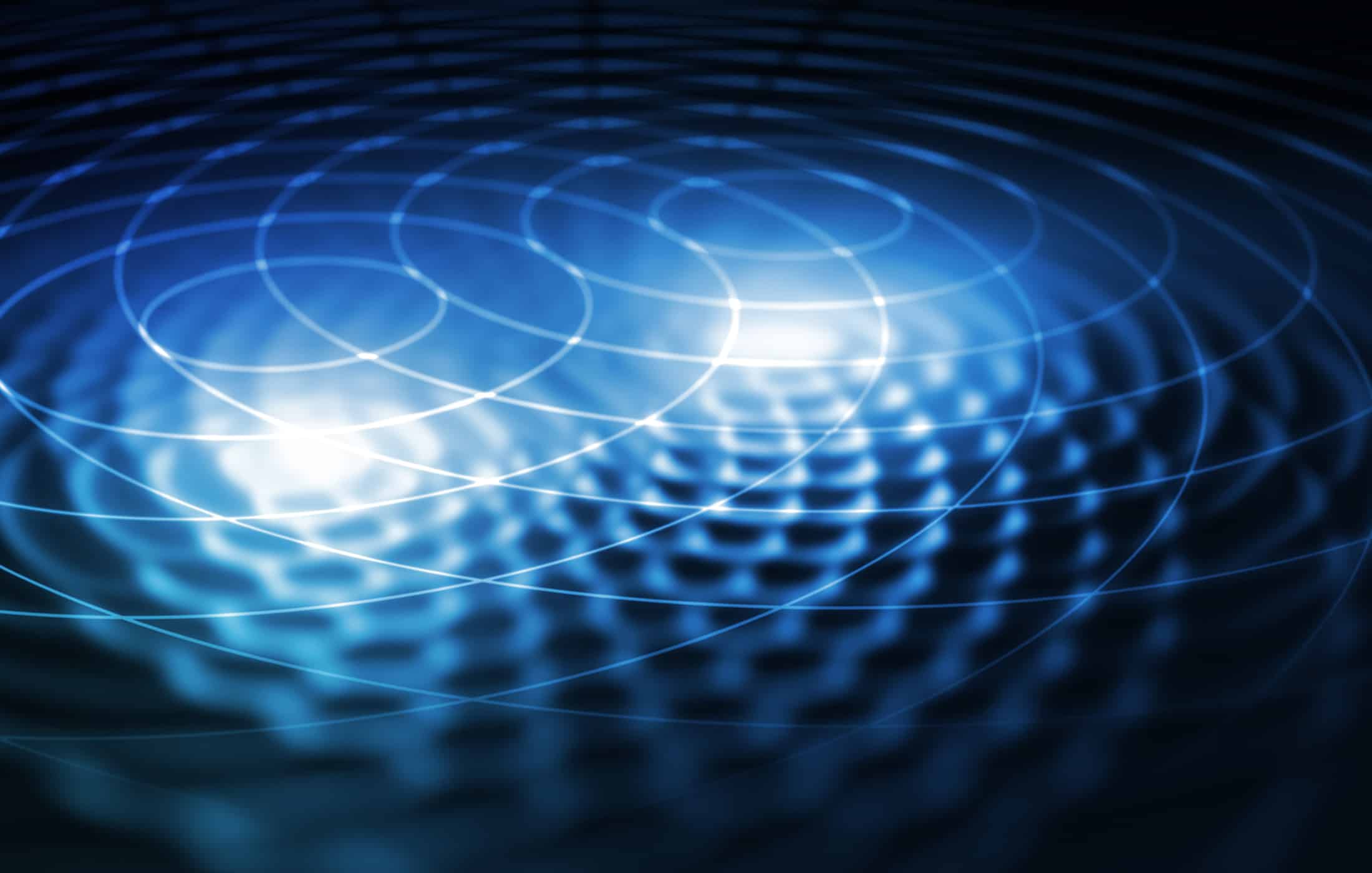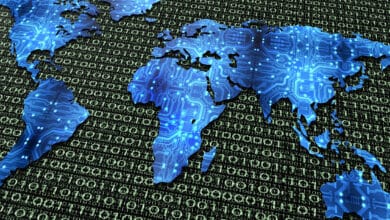Schrödinger’s Wave Equation

Table of Contents
What Is Schrödinger’s Equation?
Schrödinger’s equation is essentially the master instruction set for quantum systems – the quantum-world analogue of Newton’s famous $$F=ma$$ in classical physics. In short, Schrödinger’s equation is to quantum mechanics what Newton’s second law is to classical mechanics: a fundamental law of motion describing how a physical system will change over time. It was formulated in 1925–26 by Erwin Schrödinger, who built on the idea that particles like electrons could behave as waves. By solving this equation, Schrödinger successfully predicted the allowed energy levels (the “bound states”) of the hydrogen atom, matching experimental observations of atomic spectra. This was a stunning validation – much like how Newton’s laws predict planetary orbits, Schrödinger’s equation accurately predicted the quantized orbits of electrons in atoms.
At its core, Schrödinger’s equation is a kind of wave equation, but for probability waves. A bit more formally (without diving into calculus), the time-dependent Schrödinger equation can be written as:
$$i\hbar \frac{\partial}{\partial t}\Psi(t) = \hat{H}\Psi(t) $$
Don’t be intimidated by the notation – let’s unpack it in plain English. Here $$\Psi(t)$$ is the wave function of the system (more on that soon). The left side $$i,\hbar \frac{\partial}{\partial t}\Psi$$ essentially means “the change in the wave function over time, scaled by some constants”. The right side $$\hat{H},\Psi$$ means “apply the Hamiltonian operator $$\hat{H}$$ to the wave function”. The Hamiltonian is basically the mathematical encapsulation of the system’s total energy – it includes terms for kinetic energy and potential energy (the energies of motion and position/configuration). So the equation is saying: the way the quantum state changes in time is dictated by the system’s energy. In a sense, kinetic + potential energy = how the wave function evolves. This is analogous to how, in classical mechanics, knowing the forces (from a potential energy) lets you predict acceleration via $$F=ma$$. Schrödinger’s equation provides a time evolution rule for quantum states: if you know the state now and the governing energies, you can calculate the state at any future time.
Importantly, Schrödinger’s equation is linear and deterministic. Linear means if you have two possible wave patterns the system could follow, the equation allows a combination (superposition) of both as a valid solution. Deterministic means that the evolution is predictable in time: given the wave state now, the equation will produce the wave state a moment later with no randomness during the evolution. This smooth, reversible evolution is often compared to a kind of “quantum clockwork” ticking along. However, the deterministic wave evolution only persists until a measurement is made, at which point a different rule seems to take over.
The Wave Function: Quantum State and Probability
If Schrödinger’s equation is the rule for evolution, the wave function $$\Psi$$ is the object that evolves. The wave function is a central concept in quantum mechanics – it’s essentially a mathematical description of the quantum state of a system. In classical physics, to describe (for example) a flying baseball, you’d list precise values like its position and momentum. In quantum mechanics, you instead have $$\Psi$$, which encodes a spread of possibilities. All the information about a particle or system is contained in this wave function. What does that actually mean? It means $$\Psi$$ is like a probability wave – at any given moment, $$\Psi$$ assigns a complex number (an amplitude) to each possible outcome (such as a particle being at point x in space, or having a momentum p).
Crucially, the probability of finding the particle in a particular state is given by the square of the wave function’s amplitude. If you take the absolute value squared of $$\Psi(x)$$, written $$|\Psi(x)|^2$$, you get a real number representing the probability density of the particle being at position $$x$$. For example, if an electron’s wave function is spread out, $$|\Psi(x)|^2$$ might form a cloud – brighter where the electron is more likely to be found, fainter where it’s unlikely. This is a core postulate of quantum mechanics (born from Max Born’s interpretation): $$\Psi$$ itself isn’t directly observable, but $$|\Psi|^2$$ tells us the probabilities of observable outcomes.
Superposition: The wave function can simultaneously embody multiple possibilities – this is the famous superposition principle. Unlike a classical coin which is either heads or tails, a quantum “coin” (say a qubit) can be in a state where $$\Psi$$ has significant amplitude for both heads and tails at once. Schrödinger’s equation allows these multiple components of $$\Psi$$ to coexist and interfere with each other, much like overlapping waves. It’s as if a single computation can explore many paths in parallel – a fact that is profoundly important in quantum computing. The flip side is that when we actually observe the system, we only ever see one outcome (more on that later under measurement). But until that observation, $$\Psi$$ literally represents many possibilities at once.
To build intuition, physicists often describe $$\Psi$$ as a “cloud” or “wave” spread out in space. For example, an electron in an atom doesn’t orbit like a planet; instead, its wave function forms a standing wave around the nucleus (the shapes of these standing waves are the atomic orbitals). Schrödinger’s equation mathematically yields these orbital shapes and their energies. Another example: a free electron moving through space has a wave function that can spread out like a ripple. If unobserved, that electron is not at one single point; its existence is smeared out, governed by $$\Psi$$.
Now, this idea can sound very non-intuitive – after all, we don’t see everyday objects like tables or people behaving like spread-out waves of probability. Why not? The reason is that for large, macroscopic objects, the quantum wavelength associated with them is extremely tiny. According to de Broglie’s relation, a baseball moving at typical speed has a wavelength billions of times smaller than an atom – effectively zero for practical purposes. Thus, any wave behavior is imperceptibly small. Additionally, big objects constantly interact with their environment, causing their would-be wave functions to decohere (i.e. collapse into a definite state). So, while in principle everything has a wave function, in practice Schrödinger’s equation most visibly manifests for microscopic things like electrons, photons, or maybe molecules in carefully controlled experiments. As a heuristic: quantum superpositions are delicate, and the larger or “hotter” an object is, the faster those superpositions are destroyed by interactions with the environment. This is why we don’t observe familiar large-scale wave interference with people or chairs – their $$\Psi$$ waves are ridiculously short and snuffed out almost immediately by the surrounding environment.
How Schrödinger’s Equation Evolves the Wave Function
So, the wave function $$\Psi$$ encodes the state of a quantum system. Schrödinger’s equation tells us how $$\Psi$$ changes over time – it’s essentially the update rule for the quantum state. If you provide the equation with an initial wave function (at time $$t=0$$) and specify the system’s Hamiltonian (i.e. the energy landscape the particle feels), the equation will output $$\Psi(t)$$ at any later time t. In this way, it plays a role analogous to predicting future states that Newton’s laws play in classical mechanics.
One way to think of this is to imagine $$\Psi$$ as a kind of musical chord made of many notes (each note corresponds to a possible state). Schrödinger’s equation dictates how the chord progresses over time – some notes might change in amplitude or phase, interfering with others. But importantly, the evolution is smooth and unitary. “Unitary” is a physics/math term meaning the total probability is conserved and the evolution is reversible. No probability mysteriously appears or disappears from the wave function as time goes on; it only flows or redistributes from one possibility to another (much like an incompressible fluid). This is why, for instance, if an electron’s wave starts localized in one region, Schrödinger’s equation might cause it to flow out and spread into other regions over time, but the total integrated $$|\Psi|^2$$ (which equals 1, representing 100% certainty that the electron exists somewhere) remains constant. In practical terms, Schrödinger’s equation will never predict your electron just vanishing – it will merely predict its cloud of probability diffusing or moving according to the forces present.
Another intuition: interference. Since $$\Psi$$ is wave-like, different parts of the wave can interfere as the equation evolves them. This is analogous to how ripples on water interact – sometimes merging to form bigger waves (constructive interference) or canceling each other out (destructive interference). Quantum mechanically, this interference is what gives rise to phenomena like diffraction patterns and the ability of quantum algorithms to amplify correct answers while canceling wrong ones. Schrödinger’s equation is the mathematical engine that makes this interference happen in a consistent way. A stationary wave function (one that corresponds to a system with definite energy) will just oscillate in place (like a standing wave, yielding no change in $$|\Psi|^2$$ distribution). But a non-stationary $$\Psi$$ will evolve such that its different components beat against each other, slosh around, etc., following the equation’s guidance.
It’s worth noting that Schrödinger’s equation comes in two flavors: time-dependent (the full version we’ve been discussing) and time-independent. The time-independent Schrödinger equation is essentially the version used for static situations – it boils down to an eigenvalue problem $$\hat{H}\Psi = E\Psi$$. This equation lets you find special states $$\Psi$$ that don’t change shape in time (they only pick up a phase oscillation) and the specific energies $$E$$ associated with them. Those energies $$E$$ are the quantized energy levels of the system. For example, solving $$\hat{H}\Psi = E\Psi$$ for an electron in a hydrogen atom yields the famous energy levels ($$E_1, E_2, E_3, \dots$$) that match the observed spectral lines of hydrogen. That’s how Schrödinger’s theory explained why atoms emit light at certain frequencies – each frequency comes from an electron transitioning between quantized energy eigenstates given by this equation. In short, the time-independent equation gives you the allowed states and energies, while the time-dependent equation tells you how combinations of those states evolve in time.
Continuous Evolution vs Measurement: Schrödinger vs. Collapse
The double-slit experiment highlights a core mystery of quantum mechanics. When not observed, an electron’s wave function $$\Psi$$ goes through both slits and interferes with itself, creating a wave-like interference pattern as predicted by Schrödinger’s equation. When observed (measured) – say, if we put a detector at the slits or simply look at where each electron hits the screen – the electron appears as a localized particle going through one slit or the other, and the interference pattern disappears. In other words, the act of measurement seems to force the wave function to “collapse” into a single outcome. Before measurement, the electron’s $$\Psi$$ was a superposition of “went through slit A” and “went through slit B” (and many points in between); after measurement, the wave function has collapsed to a state consistent with “the electron went through this specific slit and hit this specific point.” The interference fringes (which require the coherence of both possibilities) vanish once we pin down the particle’s path.
In standard quantum theory, we acknowledge two different modes of evolution for a quantum system:
- Unitary evolution (continuous): This is the ordinary Schrödinger evolution. The wave function changes smoothly and predictably according to Schrödinger’s equation when the system is isolated and not being measured. This is sometimes called coherent evolution – the phase relationships (the “interference capability”) in $$\Psi$$ are intact.
- Measurement (collapse): This is a special, non-smooth change that occurs when we observe or measure the system. Upon measurement, the wave function appears to instantaneously jump to a single state consistent with the measurement result, and all the other possibilities in the superposition vanish (at least for that system). This is the infamous “wave function collapse.”
In fact, collapse and continuous Schrödinger evolution are often treated as two distinct processes by which quantum systems change. During ordinary evolution, no information leaks to the outside world and $$\Psi$$ follows Schrödinger’s equation. During a measurement, interaction with a measuring device or observer causes a break in that evolution, yielding a single random outcome in accordance with $$|\Psi|^2$$ probabilities.
One key point is that Schrödinger’s equation itself does not describe or include collapse – the equation would happily keep evolving a superposition forever if not interrupted. The collapse upon measurement has to be added as an extra postulate in quantum mechanics. In the Copenhagen interpretation (the textbook view), this is just how nature works: we use Schrödinger’s equation to predict the probabilities, and when we measure, we get one concrete result and update the wave function to reflect that outcome (this updating is the collapse). It’s a bit unsatisfying because it introduces a non-deterministic, almost magical step in a otherwise deterministic theory – Einstein, Schrödinger, and many others were uncomfortable with this, as it seemed to leave something unexplained.
This measurement problem has led to multiple interpretations and debates. For instance, the Many-Worlds Interpretation posits that there is no collapse at all – instead, all outcomes of the wave function happen, each in a separate branch of a vast multiverse. In this view, Schrödinger’s equation never breaks; the universe’s wave function just keeps evolving, splitting into non-interacting branches that correspond to different measurement results. Another view, objective collapse theories, suggests that collapse is a real physical process that happens spontaneously to large systems (thus bridging the gap between quantum and classical). There are also pilot-wave (de Broglie–Bohm) theories, where particles always have definite positions guided by a pilot wave (the wave function), removing the randomness but at the cost of accepting instantaneous influences. The bottom line is, no single interpretation has been universally accepted, and the exact mechanism of that wave function “jump” during measurement remains an open question in the foundations of physics.
What’s important for practical purposes is that we have a recipe that works: Use Schrödinger’s equation to let the wave function evolve (for example, an electron propagating through both slits as a wave), and use the collapse rule when a measurement or detection is made (the electron shows up at a definite spot on the screen). This dual mode of evolution – continuous vs. collapse – is one of the defining features of quantum mechanics, and it has no parallel in classical physics. There is no “collapse” in Newton’s laws; a baseball’s position is always well-defined. But in quantum land, an electron can travel as a delocalized wave and then materialize at a single location when we look. As strange as this is, it’s supported by decades of experiments. Understanding this dichotomy is crucial for fields like quantum computing and quantum cryptography, because it’s exactly the fragile coherence vs. measurement collapse trade-off that we struggle with when building quantum technologies (for instance, qubits must remain unmeasured and coherent during computation, but at the end we must measure them to get an answer).
From Molecules to Qubits: Real-World Applications
Schrödinger’s equation might sound abstract, but it’s at the heart of many concrete technologies and research areas. Here are a few real-world arenas where Schrödinger’s equation plays a central role:
Quantum Chemistry & Materials
In chemistry and materials science, Schrödinger’s equation is the starting point for understanding how atoms and molecules behave. The equation is used to calculate the wave function of a molecule, which provides insight into the molecule’s electronic structure and properties. Essentially, if you want to predict how a certain drug molecule binds to a protein, or what the band structure of a new material might be, you need to solve Schrödinger’s equation (at least approximately) for that system. This is computationally very challenging – for anything beyond the smallest molecules, classical computers struggle because the quantum state space grows exponentially. Here’s where quantum computing comes in: quantum computers are inherently built on quantum states and can, in principle, simulate other quantum systems much more efficiently.
Researchers are excited about using quantum computers to tackle chemistry problems by directly simulating Schrödinger’s equation for large, complex molecules. In fact, quantum algorithms like quantum phase estimation and variational algorithms are being developed to find the energies of molecular systems by effectively “diagonalizing” the molecular Hamiltonian on a quantum device. The long-term vision is to have quantum computers design new materials or drugs by solving Schrödinger’s equation for systems that are impossible to handle classically – something that could revolutionize industries by enabling discoveries of high-temperature superconductors, efficient solar cells, or tailor-made pharmaceuticals.
Quantum Algorithms & Simulation
Schrödinger’s equation doesn’t just live on paper – it inspires algorithms. Many quantum algorithms can be understood as clever applications of controlled Schrödinger evolution. A great example is the concept of quantum walks. A quantum walk is the quantum counterpart of a random walk (think of how Google’s PageRank uses random walks on the web graph, or how many algorithms explore networks randomly). In a continuous-time quantum walk, a particle’s wave function evolves on a graph according to Schrödinger’s equation, with the graph’s structure playing the role of the “potential landscape” the particle feels. The result is that the particle’s amplitude spreads over paths in the graph in a way that can profoundly outperform classical random exploration – it’s like the particle explores all paths in superposition.
Quantum walk algorithms have been designed for fast searching and graph traversal problems, leveraging the fact that the wave function can interfere to amplify desired outcomes. More broadly, any quantum circuit you execute on a quantum computer can be viewed as simulating a series of Schrödinger evolutions. The basic logic gates (Hadamard, CNOT, Pauli rotations, etc.) correspond to applying specific Hamiltonians for specific durations to achieve a controlled evolution. In fact, one could say a quantum computer is essentially a machine that sets up a desired Hamiltonian $$\hat{H}$$ and lets Schrödinger’s equation do the computing for a short time.
This viewpoint – quantum computing as engineered Schrödinger dynamics – is especially relevant in analog quantum simulators, where, for example, an experimentalist might program the interactions (Hamiltonian) among 100 qubits so that their collective Schrödinger evolution mimics the behavior of some target system (like electrons in a material). The ability to harness Schrödinger’s equation in this way is why Richard Feynman envisioned quantum computers in the first place: nature is quantum, so let’s use a quantum device to simulate nature.
Quantum Hardware (Qubits in Action)
On the hardware level, Schrödinger’s equation is literally what’s happening when a qubit changes state. Take a simple single qubit – say it’s implemented as the spin of an electron, or the orientation of a photon’s polarization, or a current in a tiny superconducting loop. To perform a quantum gate (like flipping a qubit from $$|0\rangle$$ to $$|1\rangle$$, or creating a superposition), experimentalists apply controlled pulses of fields (microwave pulses, laser pulses, etc.). These pulses effectively set the Hamiltonian for the qubit (for example, a magnetic field interacting with a spin). Schrödinger’s equation then dictates how the qubit’s wave function evolves under that influence. By timing the pulse precisely, one can rotate the qubit’s state to the desired target state. In other words, doing a quantum operation is equivalent to solving the time-dependent Schrödinger equation for that qubit for a specific duration and interaction.
A concrete example: in many quantum computing platforms, a Rabi oscillation is used to flip qubits. You apply a resonant pulse and the qubit’s probability “oscillates” from 0 to 1 and back again in a sinusoidal fashion – that oscillation is a solution of Schrödinger’s equation for a two-level system being driven by a field. By stopping at just the right time (half an oscillation), you’ve taken a $$|0\rangle$$ to $$|1\rangle$$ (that’s your NOT gate). Stop at a quarter oscillation, and you’ve made an equal superposition $$(|0\rangle+|1\rangle)/\sqrt{2}$$ (essentially a Hadamard operation). All of this is predicted by Schrödinger’s equation, and hardware engineers rely on that prediction to design pulse sequences that implement quantum logic. Furthermore, understanding Schrödinger’s equation is vital when scaling up quantum processors: it helps in analyzing phenomena like decoherence (when a qubit’s wave function starts entangling with its environment and effectively collapses), and in designing error correction – which is all about keeping the system’s $$\Psi$$ following nice unitary evolution despite disturbances.
These examples show that Schrödinger’s equation isn’t just an esoteric formula from 1920s physics – it’s a practical tool and theoretical backbone in today’s quantum technology. Whether it’s simulating a new molecule, running a quantum algorithm, or calibrating a qubit chip, the equation is the consistent thread guiding our understanding of dynamics in the quantum realm.
Why Schrödinger’s Equation Matters
As someone working at the intersection of technology, security, and quantum science, I often emphasize that understanding Schrödinger’s equation is key to understanding quantum technology. It’s the theoretical bedrock underlying quantum computing, quantum cryptography, and much of modern nanotechnology. Whenever you hear about a quantum computer tackling a difficult problem, or quantum cryptographers exploiting the laws of physics for secure communication, Schrödinger’s equation is humming in the background, governing the behavior of qubits or particles involved.
You can think of Schrödinger’s equation as the operating system of the quantum world – it’s always running, updating the state of the quantum “software” (the wave function). Just as a good understanding of an OS helps a programmer write better code, understanding Schrödinger’s equation helps us design better quantum algorithms and hardware. It teaches us how information can be encoded in waves of probability and how nature processes that information when we’re not looking. It also teaches us where the pitfalls lie: the moment we peek (measure), the quantum OS “crashes” in a sense – the wave function resets to a definite state. Balancing on that knife-edge – keeping quantum systems isolated enough to evolve coherently, but controllable enough to do something useful – is the central challenge of quantum engineering.
On a more philosophical note, Schrödinger’s equation changed our view of reality. It tells us that determinism and predictability live at the heart of quantum mechanics (through the equation’s smooth evolution), yet it coexists with randomness and uncertainty (in the act of measurement). This duality forces us to rethink concepts of cause and effect, and even reality itself – are particles “real” if they exist as delocalized waves of possibility? Debates continue, but what’s clear is that Schrödinger’s humble-looking equation – a line of math born from a physicist’s intuition and a few clever guesses – has proven extraordinarily powerful. It has unlocked the design of lasers, transistors, MRI machines, and now is unlocking quantum computers.
Quantum Upside & Quantum Risk - Handled
My company - Applied Quantum - helps governments, enterprises, and investors prepare for both the upside and the risk of quantum technologies. We deliver concise board and investor briefings; demystify quantum computing, sensing, and communications; craft national and corporate strategies to capture advantage; and turn plans into delivery. We help you mitigate the cquantum risk by executing crypto‑inventory, crypto‑agility implementation, PQC migration, and broader defenses against the quantum threat. We run vendor due diligence, proof‑of‑value pilots, standards and policy alignment, workforce training, and procurement support, then oversee implementation across your organization. Contact me if you want help.



